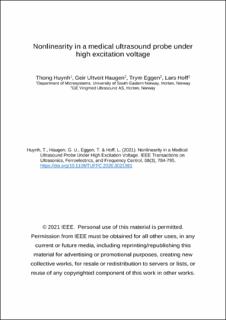| dc.contributor.author | Huynh, Thong | |
| dc.contributor.author | Haugen, Geir Ultveit | |
| dc.contributor.author | Eggen, Trym Haakon | |
| dc.contributor.author | Hoff, Lars | |
| dc.date.accessioned | 2022-05-27T12:30:02Z | |
| dc.date.available | 2022-05-27T12:30:02Z | |
| dc.date.created | 2020-11-24T14:49:23Z | |
| dc.date.issued | 2020 | |
| dc.identifier.citation | Huynh, T., Haugen, G. U., Eggen, T. & Hoff, L. (2021). Nonlinearity in a Medical Ultrasound Probe Under High Excitation Voltage. IEEE Transactions on Ultrasonics, Ferroelectrics, and Frequency Control, 68(3), 784-795. | en_US |
| dc.identifier.issn | 0885-3010 | |
| dc.identifier.uri | https://hdl.handle.net/11250/2996486 | |
| dc.description.abstract | Tissue harmonic imaging is often the preferred ultrasound imaging modality due to its ability to suppress reverberations. The method requires good control of the transmit stage of the ultrasound scanner, as harmonics in the transmitted ultrasound pulses will interfere with the harmonics generated in the tissue during nonlinear propagation, degrading image quality. In this study, a medical ultrasound probe used in tissue harmonic imaging was experimentally characterized for transmitted 2nd harmonic distortion to identify and compare sources of nonlinear distortion in the probe and transmit electronics. The system was tested up to amplitudes above what is found during conventional operation, pushing the system to the limits in order to investigate the phenomenon. Under these conditions, 2nd harmonic levels up to -20 dB relative to the fundamental frequency were found in the ultrasound pulses transmitted from the probe. The transmit stage consists of high-voltage transmit electronics, cable, tuning inductors, and the acoustic stack. The contribution from the different stages in the ultrasound transmit chain was quantified by separating and measuring at different positions. Nonlinearities in the acoustic transducer stack were identified as the dominating source for 2nd harmonics in the transmitted ultrasound pulses. Contribution from other components, e.g. transmit electronics and cable and tuning circuitry, were found to be negligible compared to that from the acoustic stack. Investigation of the stack’s electrical impedance at different driving voltages revealed that the impedance changes significantly as function of excitation voltage. The 2nd harmonic peak in the transmitted pulses can be explained by this nonlinear electrical impedance distorting the driving voltage and current. | en_US |
| dc.language.iso | eng | en_US |
| dc.title | Nonlinearity in a medical ultrasound probe under high excitation voltage | en_US |
| dc.type | Peer reviewed | en_US |
| dc.type | Journal article | en_US |
| dc.description.version | acceptedVersion | en_US |
| dc.rights.holder | © 2021 IEEE. | en_US |
| dc.source.pagenumber | 784-795 | en_US |
| dc.source.volume | 68 | en_US |
| dc.source.journal | IEEE Transactions on Ultrasonics, Ferroelectrics and Frequency Control | en_US |
| dc.source.issue | 3 | en_US |
| dc.identifier.doi | https://doi.org/10.1109/TUFFC.2020.3021981 | |
| dc.identifier.cristin | 1851759 | |
| dc.relation.project | Norges forskningsråd: 245963 | en_US |
| dc.relation.project | Norges forskningsråd: 237887 | en_US |
| cristin.ispublished | true | |
| cristin.fulltext | postprint | |
| cristin.qualitycode | 1 | |
